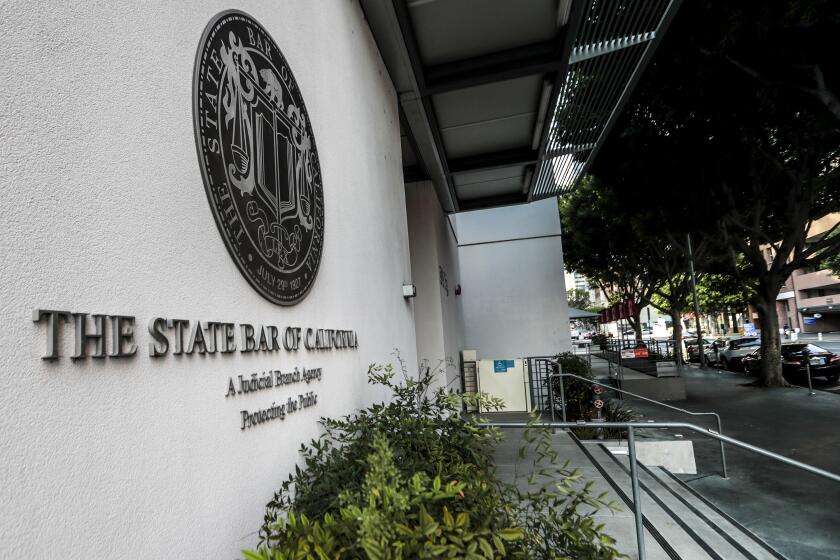California bullet train deal: Hundreds of millions of dollars
- Share via
Reporting from Sacramento — California’s controversial bullet train would receive hundreds of millions of dollars in the coming year under a budget deal reached by Gov. Jerry Brown and lawmakers Thursday, a critical step toward beginning construction as the project continues to face legal and political challenges.
The agreement is one of several reached as the spending plan continued to take shape ahead of Sunday’s deadline. Democratic lawmakers successfully fought the governor’s proposal to cap how many hours caregivers could work in the state home care program, but they were unable to secure extra money for court operations or increase payments to doctors who serve poor patients enrolled in government healthcare.
Bullet train funding had been a sticking point in budget negotiations. The money would be drawn from the cap-and-trade program, which charges fees to polluters who emit greenhouse gases above certain limits. Under the budget deal, $250 million would be allocated to high-speed rail in the next fiscal year, which begins July 1. In each following year, the bullet train would receive 25% of cap-and-trade revenue.
The final figures represent a compromise between Brown, who wanted 33% for the train, and Democratic lawmakers, who offered 15%.
Cap-and-trade could provide billions of dollars for the bullet train over the next several years, a relatively small chunk of the project’s overall $68-billion price tag. However, the money would arrive at a critical time. Voter-approved bond funding has been stalled by lawsuits, and the state needs to begin matching federal grants with its own dollars next month.
H.D. Palmer, spokesman for Brown’s Department of Finance, said the governor is pleased that the budget includes “an ongoing source of funding to move this project forward.”
The cap-and-trade program provides the “single largest new source of capital into our budget,” said Assemblyman Richard Bloom (D-Santa Monica), and the money is required by law to be spent on programs that reduce greenhouse gas emissions.
Apart from the 25% earmarked for high-speed rail, the budget deal would direct 35% of cap-and-trade funds to other transit projects and affordable housing. The rest of the money would be available for initiatives involving natural resources, energy efficiency and cleaner forms of transportation.
A final vote on the budget is scheduled Sunday. Once approved, it goes to the governor, who can veto spending he doesn’t like.
The plan includes a one-time allocation of $40 million for court construction, less than the $100-million annual funding increase sought by Democratic lawmakers. Courts have been hit hard by budget cuts over the last several years, and Chief Justice Tani Cantil-Sakauye has said more money is needed just “to tread water.”
“The new trial court budget is simply insufficient for those who need access to a courthouse,” Contra Costa County Presiding Superior Court Judge Barry Goode said. “Crime victims, law enforcement, those suffering from domestic violence, families in trouble and other court users will continue to have to travel long distances and endure long waits for justice.”
In another setback for Democratic lawmakers, Brown refused to reverse a 10% cut in reimbursement rates for doctors who treat patients in the state healthcare program for the poor, known as Medi-Cal. Healthcare advocates say that the cut has made it more difficult for patients to receive medical care, especially at a time when Medi-Cal enrollment is soaring under President Obama’s federal overhaul.
Administration officials estimate that nearly one out of three Californians will receive healthcare through Medi-Cal by next year.
“All of us have real concerns about access,” Senate Budget Chairman Mark Leno (D-San Francisco) said.
However, a deal was reached to avoid upheaval in California’s home care program, which helps low-income elderly and disabled residents. New federal regulations require overtime pay for caregivers, which Brown originally wanted to avoid by capping the number of hours they could work. The proposal would have reduced income for some caregivers and forced severely disabled residents to rely on multiple workers for assistance, such as cleaning, cooking and bathing.
Union officials and disability advocates mounted an intense lobbying effort to prevent the proposed cap from taking effect, and the governor eventually relented. The deal includes money for overtime and guidelines to prevent costs from surging.
“It’s a big victory,” said Deborah Doctor, a lobbyist for Disability Rights California.
Follow @chrismegerian for more updates from Sacramento.
Times staff writer Maura Dolan in San Francisco contributed to this report.
More to Read
Sign up for Essential California
The most important California stories and recommendations in your inbox every morning.
You may occasionally receive promotional content from the Los Angeles Times.











